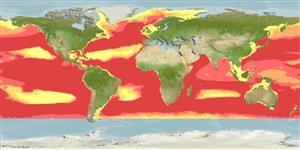Common names from other countries
Teleostei (teleosts) >
Lophiiformes (Anglerfishes) >
Ceratiidae (Warty Seadevils)
Etymology: Cryptopsaras: Greek, kryptos =secret, hidden + Greek, psaras = fisherman (referring to this genus' tiny illicial bone, almost entirely covered by tissue of the esca) (Ref. 86949); couesii: Named for the eminent ornithologist Elliot Coues (Ref. 4525).
More on author: Gill.
Environment: milieu / climate zone / depth range / distribution range
Ecology
Marine; bathypelagic; depth range 0 - 3085 m (Ref. 58018), usually 500 - 1250 m (Ref. 36494). Deep-water; 81°N - 52°S, 180°W - 180°E
Circumglobal: tropical and subtropical.
Size / Weight / Age
Maturity: Lm ? range ? - ? cm
Max length : 7.3 cm TL male/unsexed; (Ref. 4494); 44.0 cm TL (female)
Males dwarfed, becoming parasitic on females. Maximum size of free-living males is 1.05 cm (Ref. 4494). Females are oviparous, with planktonic larvae (Ref. 36494). Eggs are presumably contained in floating gelatinous rafts (Ref. 36494 ).
Females are oviparous, males are parasitic (Ref. 36494).
Bertelsen, E., 1990. Ceratiidae. p. 510-512. In J.C. Quero, J.C. Hureau, C. Karrer, A. Post and L. Saldanha (eds.) Check-list of the fishes of the eastern tropical Atlantic (CLOFETA). JNICT, Lisbon; SEI, Paris; and UNESCO, Paris. Vol. 1. (Ref. 4494)
IUCN Red List Status (Ref. 130435)
CITES (Ref. 128078)
Not Evaluated
Threat to humans
Harmless
Human uses
Fisheries: of no interest
Tools
Special reports
Download XML
Internet sources
Estimates based on models
Preferred temperature (Ref.
115969): 2.8 - 10.4, mean 5.6 (based on 2308 cells).
Phylogenetic diversity index (Ref.
82804): PD
50 = 1.0625 [Uniqueness, from 0.5 = low to 2.0 = high].
Bayesian length-weight: a=0.01995 (0.00906 - 0.04395), b=3.01 (2.83 - 3.19), in cm Total Length, based on all LWR estimates for this body shape (Ref.
93245).
Trophic level (Ref.
69278): 4.5 ±0.37 se; based on food items.
Resilience (Ref.
120179): Medium, minimum population doubling time 1.4 - 4.4 years (tm=5).
Fishing Vulnerability (Ref.
59153): Low to moderate vulnerability (34 of 100).
